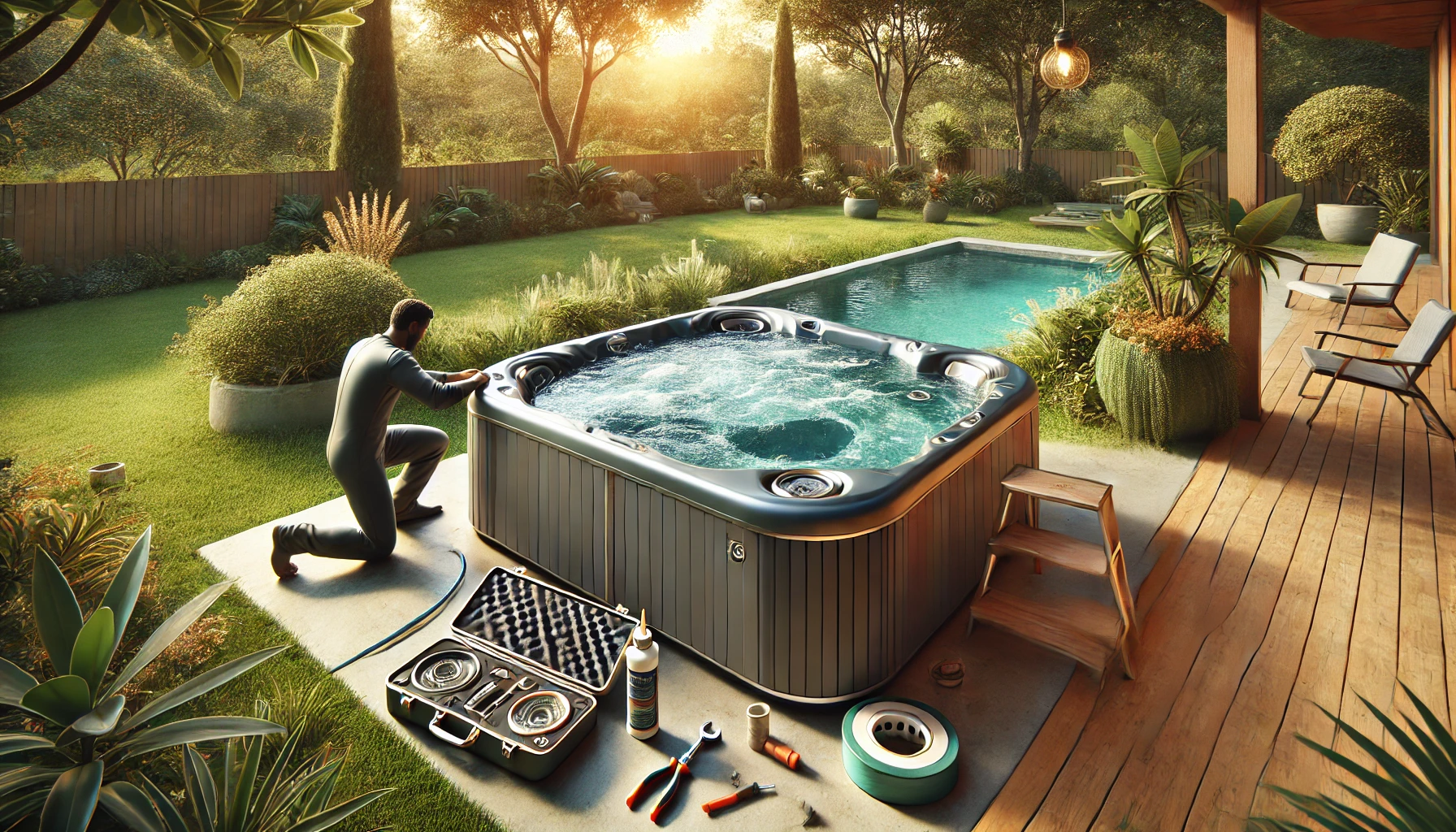Hey there, fellow hot tub enthusiasts! Ever had that sinking feeling when you notice your beloved spa losing water faster than usual?
Yep, I’ve been there too, and let me tell you, it’s not a fun experience.
But don’t worry, I’m here to share some hard-earned wisdom on how to fix a hot tub leak. Trust me, after years of dealing with these watery woes, I’ve picked up a trick or two that’ll save you time, money, and a whole lot of headaches.
So grab a cuppa, settle in, and let’s dive into the world of hot tub leak repair. It might seem daunting at first, but I promise you’ll be a pro in no time!
How To Fix A Hot Tub Leak
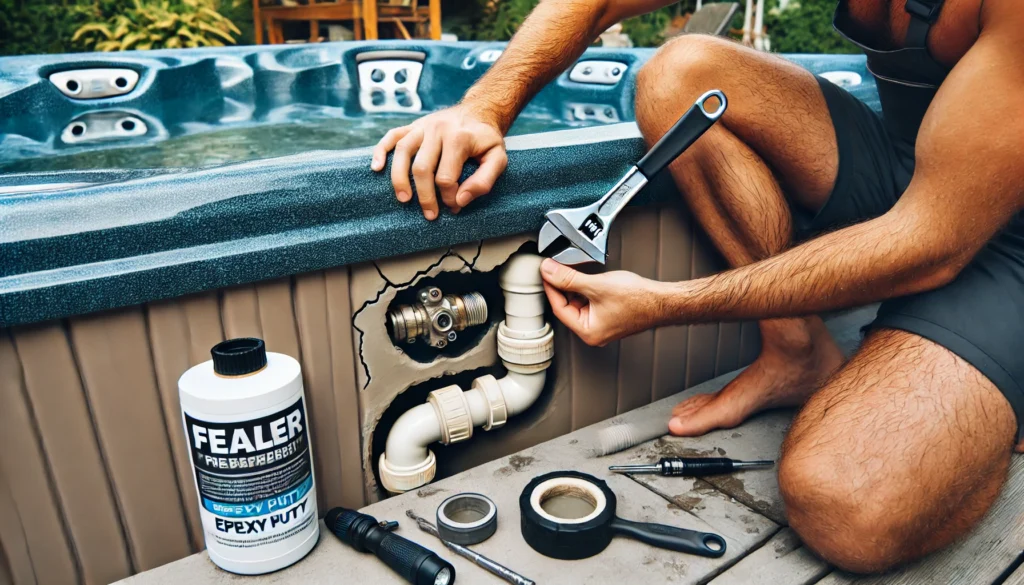
As someone who’s dealt with many hot tub leaks over the years, I can tell you that fixing a hot tub leak involves a few key steps. First, you’ll need to locate the source of the leak, which can be tricky but is crucial.
Once you’ve found it, the fix depends on where the leak is coming from. It could be as simple as tightening a loose fitting or as complex as patching a crack in the shell.
Sometimes, you might need to replace a faulty component entirely. While many leaks can be fixed with basic DIY skills, some require professional help.
Don’t worry, though – we’ll dive deeper into each of these aspects as we explore the ins and outs of hot tub leak repair below!
1. Identifying the Source of Your Hot Tub Leak
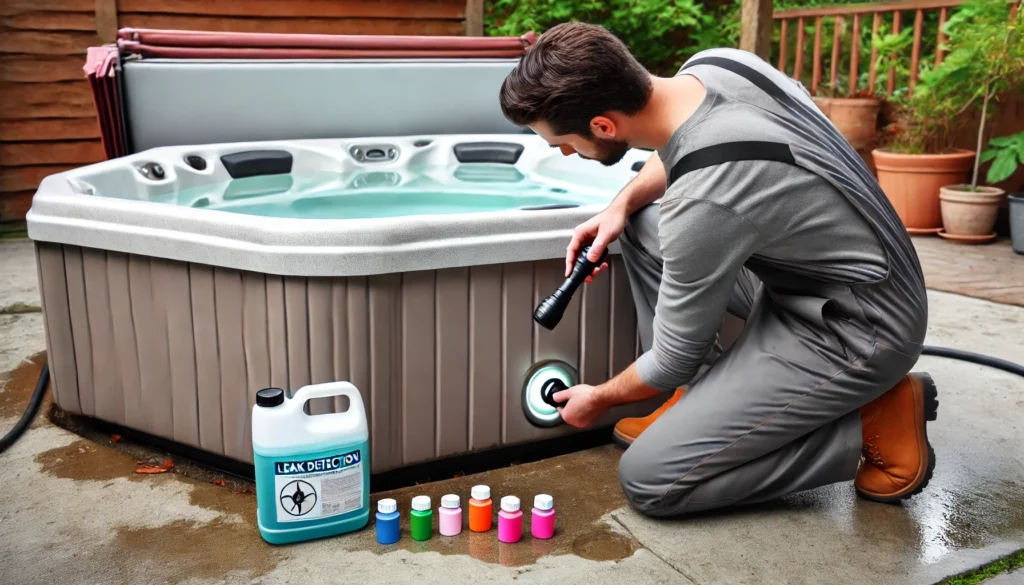
Alright, folks, let’s get down to business. The first step in fixing a hot tub leak is finding out where the heck that water’s escaping from.
It’s like being a detective, but instead of solving crimes, you’re tracking down sneaky water trails. I remember the first time I tried to locate a leak in my old spa – I was running around like a headless chicken, totally clueless!
Here’s the deal: start with a good ol’ visual inspection. Get down on your hands and knees (I know, not the most glamorous position) and look for any obvious signs of water escape.
Check around the base of the tub, the equipment area, and all those nooks and crannies. Sometimes, you’ll get lucky and spot a puddle or a damp patch right away.
But what if you can’t see anything obvious? Well, that’s when you gotta get creative.
One of my favorite tricks is using food coloring or a special leak detection dye. Just squeeze a few drops near where you suspect the leak might be, and watch carefully.
If there’s a leak, you’ll see the colored water being sucked out. It’s like magic, I swear!
Now, let’s talk about the usual suspects. In my experience, jets are often the culprits.
Those little buggers can develop leaks around their fittings or even crack over time. Then there are pumps and heaters – they’ve got moving parts and seals that can wear out.
I once had a leak that turned out to be a tiny crack in the pump housing. Took me ages to find it, but boy, was I proud when I did!
Remember, patience is key here. It might take a while to pinpoint the exact source of the leak, but trust me, it’s worth the effort.
Once you know where the water’s escaping, you’re halfway to fixing the problem. So take your time, be thorough, and don’t be afraid to get a little wet in the process.
After all, that’s half the fun of owning a hot tub, right?
2. Common Causes of Hot Tub Leaks
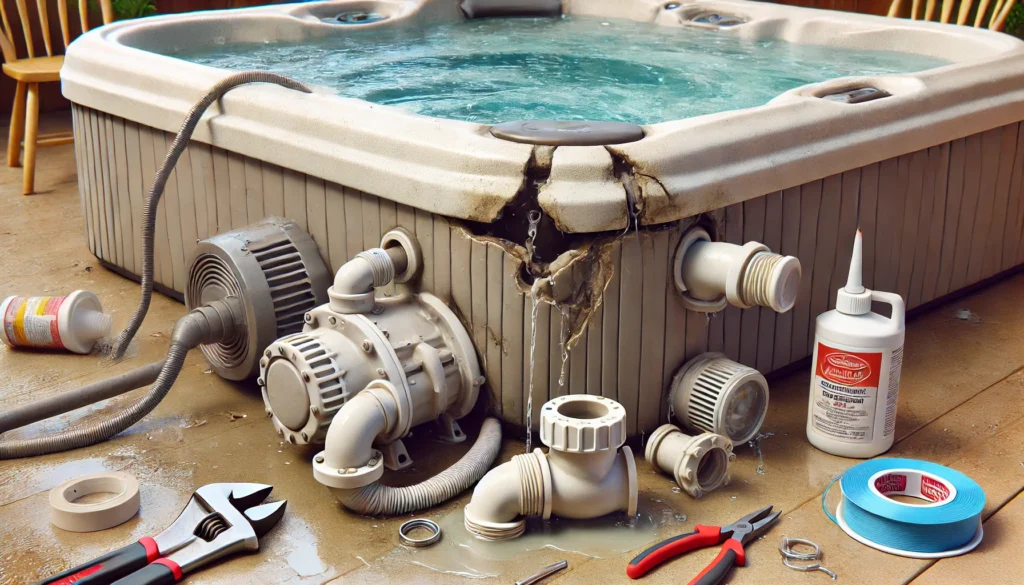
Alright, now that we’ve played detective and (hopefully) found our leak, let’s talk about why these pesky problems happen in the first place. I’ve seen my fair share of hot tub troubles over the years, and let me tell you, some causes are more common than others.
First up, we’ve got loose fittings and connections. These sneaky little devils are probably the most frequent culprits I’ve come across.
You’d be surprised how often a simple loose connection can cause a major headache! I remember one time I spent hours trying to find a leak, only to discover it was just a pipe fitting that had worked itself loose over time.
Talk about feeling like a dummy!
Then there’s the issue of cracked pipes or hoses. This one’s a real pain in the butt, especially if the crack is small or hidden.
Temperature changes, age, and even poor water chemistry can cause pipes to become brittle and crack. I learned this the hard way when I neglected my water balance for a while – ended up with a spaghetti mess of cracked pipes that cost me a pretty penny to fix.
Now, let’s chat about pump and heater issues. These are the workhorses of your hot tub, and boy, do they take a beating!
Seals can wear out, gaskets can fail, and sometimes the housings themselves can crack. I once had a pump that started leaking right in the middle of a relaxing soak.
Talk about a mood killer!
Last but not least, we’ve got shell cracks or damage. This is usually the worst-case scenario, and trust me, it’s not fun.
Cracks in the shell can be caused by all sorts of things – age, poor maintenance, even accidents (like that time my neighbor’s kid thought it’d be fun to practice his cannonballs in my empty tub… yeah, not cool).
The good news is, most of these issues are fixable with a bit of know-how and elbow grease. And hey, even if you can’t fix it yourself, knowing what’s causing the problem can save you time and money when you call in the pros.
So next time you’re faced with a leaky hot tub, don’t panic! Take a deep breath, think about these common causes, and you’ll be well on your way to getting things sorted out.
3. Tools and Materials Needed for Hot Tub Leak Repair
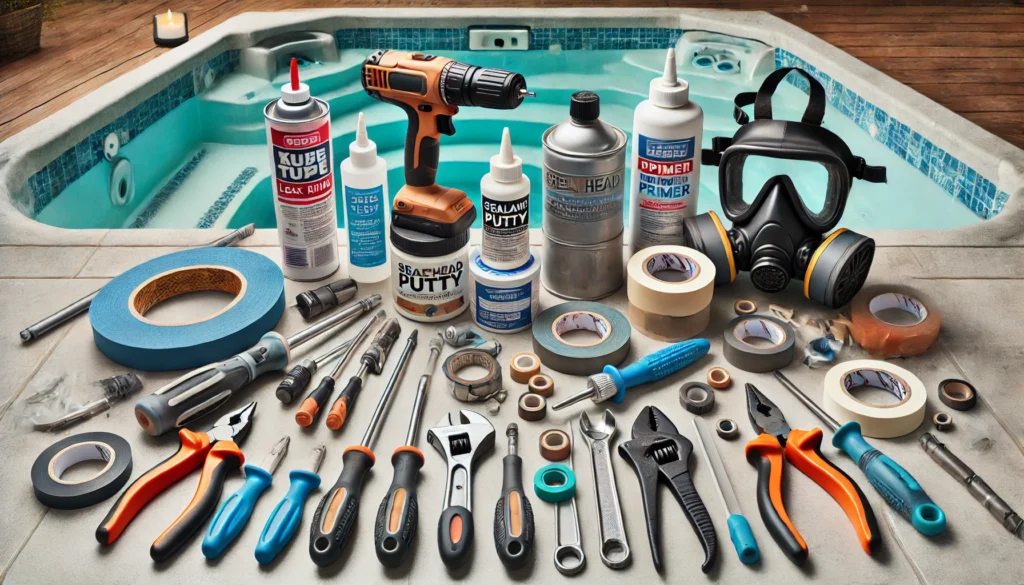
Alright, folks, it’s time to talk tools! Now, I’m not gonna lie – the first time I tried to fix a leak in my hot tub, I was about as prepared as a snowman in a heatwave.
But over the years, I’ve learned that having the right tools can make all the difference between a quick fix and a full-blown disaster.
Let’s start with the essentials for DIY repairs. You’re gonna want a good set of screwdrivers (both flathead and Phillips), some adjustable wrenches, and a pair of pliers.
Trust me, these bad boys will be your best friends when you’re trying to tighten fittings or replace parts. Oh, and don’t forget a flashlight!
I can’t tell you how many times I’ve been hunched over in the dark, cursing myself for not bringing a light.
Now, let’s talk about sealants and adhesives. This is where things get a bit tricky, ’cause not all sealants are created equal when it comes to hot tubs.
You’ll want to look for something that’s specifically designed for spa use – it needs to stand up to hot water, chemicals, and pressure. I learned this the hard way when I tried to use regular silicone caulk on a small crack.
Let’s just say it didn’t end well, and I ended up with a bigger mess than I started with!
For small cracks or leaks, I swear by two-part epoxy putty. This stuff is like magic – you just knead it together, slap it on the leak, and it hardens underwater.
For bigger jobs, you might want to invest in some specialized spa sealant or plumber’s tape. And if you’re dealing with plumbing repairs, don’t forget the PVC primer and cement!
Last but definitely not least, let’s talk safety. I know, I know – it’s not the most exciting topic, but trust me, you’ll thank me later.
Always, and I mean always, turn off the power to your hot tub before you start poking around. Water and electricity don’t mix, folks!
Grab yourself some rubber gloves to protect your hands from chemicals and sharp edges. And if you’re working with any kind of adhesive or sealant, a good respirator mask is a must.
I learned that lesson the hard way after spending an afternoon huffing fumes – not fun, let me tell you!
Remember, having the right tools isn’t just about making the job easier – it’s about doing it right and keeping yourself safe in the process. So before you dive into that repair job, take a minute to check your toolkit.
Trust me, your future self will thank you!
4. Step-by-Step Guide to Fixing Different Types of Hot Tub Leaks

Alright, buckle up, folks! We’re about to dive into the nitty-gritty of fixing those pesky hot tub leaks.
Now, I’ve had my fair share of watery mishaps over the years, so I’m gonna break this down step by step. Trust me, with a little patience and elbow grease, you’ll be back to soaking in no time!
Let’s start with the most common culprit: loose fittings and connections. These little buggers can cause big problems, but they’re usually pretty easy to fix.
First things first, drain the tub below the level of the leak. Then, grab your trusty wrench and give those fittings a good tightening.
But here’s a pro tip: don’t go all Hulk on ’em! Over-tightening can actually make things worse.
I learned that the hard way when I cracked a fitting trying to muscle it into submission. Not my finest moment, let me tell you!
Now, what if you’ve got a small crack in the shell? Don’t panic! This is where that epoxy putty I mentioned earlier comes in handy.
Drain the tub, clean the area around the crack (I mean really clean it – any dirt or grime will mess up the repair), and then knead that putty like you’re making bread. Press it firmly into the crack, smooth it out, and let it cure according to the instructions.
I once fixed a hairline crack with this method, and it’s still holding strong five years later!
Dealing with damaged pipes or hoses? This one’s a bit trickier, but don’t worry – we’ve got this!
If the damage is minor, you might be able to get away with using some specialized tape or sealant. But if it’s a bigger problem, you’re probably looking at replacing the section of pipe.
Turn off the power, drain the tub, and cut out the damaged section. Then, measure twice (trust me on this one – I’ve made some embarrassing mistakes by skimping on the measuring), and cut a new piece to fit.
Use PVC primer and cement to attach the new section, and voila! Good as new.
Last but not least, let’s talk about pump and heater leaks. These can be a real pain in the you-know-what, but they’re not impossible to fix.
Often, the problem is a worn-out seal or gasket. If you’re handy, you can usually replace these yourself – just make sure you get the exact right part for your model.
But I’ll be honest, if you’re not confident in your skills, this might be one job best left to the pros. I learned that lesson the hard way when I tried to replace a pump seal and ended up flooding my equipment area.
Not my proudest moment!
Remember, no matter what type of leak you’re dealing with, take your time and don’t be afraid to ask for help if you need it. There’s no shame in admitting when a job’s over your head – trust me, I’ve been there more times than I care to admit!
But with these steps and a little perseverance, you’ll be well on your way to a leak-free hot tub. Now, who’s ready for a soak?
5. Preventive Maintenance to Avoid Future Hot Tub Leaks
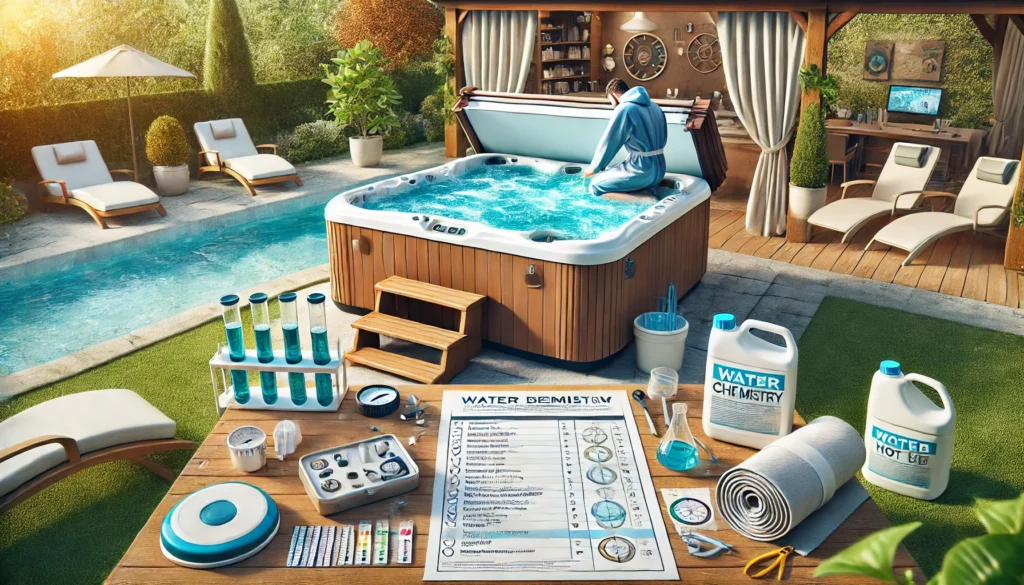
Alright, folks, let’s talk about something that’s near and dear to my heart: preventive maintenance. Now, I know it’s not the sexiest topic in the world, but trust me, a little TLC can go a long way in keeping your hot tub leak-free and running smooth as butter.
First things first, let’s chat about regular inspection routines. I can’t stress this enough – get up close and personal with your hot tub on a regular basis.
I’m talking about a good, thorough once-over at least once a month. Check all those fittings, look for any signs of wear and tear, and keep an eye out for any suspicious puddles or damp spots.
I once caught a tiny leak in its early stages just because I made a habit of running my hand along the pipes during my monthly check. Saved myself a whole lot of hassle and money, let me tell you!
Now, let’s get into the nitty-gritty of water chemistry. I know, I know – it sounds like high school science class all over again.
But trust me, maintaining proper chemical balance is crucial for preventing leaks. You see, imbalanced water can corrode your pipes and equipment over time, leading to all sorts of problems.
I learned this the hard way when I got lazy with my water testing and ended up with a corroded heater element. Talk about an expensive lesson!
So, what’s the secret formula? Well, you’ll want to keep your pH between 7.2 and 7.8, your alkalinity between 80 and 120 ppm, and your calcium hardness between 150 and 250 ppm.
And don’t forget about sanitizer levels! Whether you’re using chlorine, bromine, or something else, make sure you’re keeping it in the right range.
I test my water at least once a week, and more often if I’ve been using the tub a lot or if we’ve had a big party.
Last but not least, let’s talk about winter prep. If you live in a place where it gets cold (and I mean really cold), you’ve got to take some extra steps to protect your hot tub from freeze damage.
Trust me, there’s nothing worse than coming out to your tub on a frosty morning and finding a cracked shell or burst pipes. Been there, done that, and it ain’t pretty!
If you’re planning to use your tub through the winter, make sure it’s well-insulated and that you keep it running. But if you’re shutting it down, you’ll need to drain it completely and blow out all the pipes.
I once thought I could get away with just draining the tub and not blowing out the pipes. Big mistake!
Come spring, I had more leaks than a rusty colander. Never again!
Here’s a pro tip: even if you’re using your tub in winter, it’s a good idea to check it regularly for ice buildup, especially around the equipment area. A little preventive de-icing can save you a world of trouble down the line.
Remember, folks, prevention is always better (and cheaper) than cure. A little bit of regular maintenance might seem like a pain in the neck now, but trust me, it’s nothing compared to the headache of dealing with a major leak or equipment failure.
So roll up those sleeves, grab your test kit, and show your hot tub some love. Your future self will thank you!
6. When to Call a Professional for Hot Tub Leak Repair

Alright, my DIY warriors, let’s have a heart-to-heart about knowing when to throw in the towel and call in the cavalry. Now, don’t get me wrong – I’m all for rolling up your sleeves and getting your hands dirty.
But sometimes, you gotta know when a job is beyond your pay grade.
First off, let’s talk about the signs that a leak might be too much for a DIY fix. If you’ve tried everything we’ve discussed and that stubborn leak is still giving you the runaround, it might be time to wave the white flag.
I remember one time I spent a whole weekend chasing a leak, only to discover it was coming from a crack in the actual shell of the tub. Talk about a facepalm moment!
Another red flag is if you’re dealing with electrical components. Listen, I love a good project as much as the next guy, but messing with wiring when you’re not qualified?
That’s a recipe for disaster. I learned this lesson the hard way when I tried to fix a faulty heater and ended up tripping the breaker for my entire house.
Not my finest hour, let me tell you!
Now, let’s chat about the potential risks of improper repairs. Sure, you might save a few bucks doing it yourself, but if you don’t know what you’re doing, you could end up causing more damage in the long run.
I’ve seen simple leaks turn into major flooding disasters because someone thought they could “wing it” with the repairs. And let’s not even get started on the safety risks – mixing water and electricity is no joke, folks.
So, when should you bite the bullet and call a pro? Here’s my rule of thumb: if you’ve spent more than a day trying to fix the problem with no success, if the leak seems to be getting worse, or if you’re dealing with anything electrical, it’s time to bring in the experts.
Yeah, it might cost a bit more upfront, but trust me, it’s worth it for the peace of mind.
Speaking of costs, let’s break down the DIY vs. professional repair debate. Sure, doing it yourself can save you some cash if you know what you’re doing.
But here’s the kicker – if you mess it up, you could end up spending way more in the long run. I once tried to save a few bucks by fixing a pump myself, only to end up having to replace the entire thing because I didn’t install the seal correctly.
Talk about penny wise and pound foolish!
On the flip side, a professional might seem expensive at first, but they’ve got the tools, the know-how, and (most importantly) the warranty to back up their work. Plus, they can often spot and fix other potential issues before they become major problems.
It’s like getting a tune-up for your hot tub!
At the end of the day, there’s no shame in admitting when a job is over your head. Heck, I’ve been maintaining hot tubs for years, and I still call in the pros when I’m in over my depth.
Remember, the goal is to get your hot tub up and running safely – not to prove you’re the next Bob Vila. So if you’re feeling out of your depth, don’t be afraid to pick up the phone and call for backup.
Your hot tub (and your sanity) will thank you!
Conclusion
Whew! We’ve been on quite a journey, haven’t we? From tracking down sneaky leaks to getting our hands dirty with repairs, we’ve covered a lot of ground.
But here’s the thing – fixing a hot tub leak isn’t just about patching up holes or tightening fittings. It’s about taking care of your little slice of paradise, your own personal oasis of relaxation.
Remember, every hot tub is unique, just like its owner. What works for my tub might not be the perfect solution for yours.
That’s why it’s so important to really get to know your spa, to understand its quirks and its needs. Think of it like a relationship – the more attention and care you give it, the better it’ll treat you in return.
Now, I can’t stress this enough – safety first, folks! Whether you’re doing a simple repair or just routine maintenance, always make sure you’re following proper safety procedures.
Turn off the power, use the right tools, and if you’re ever in doubt, don’t be afraid to call in the pros. Trust me, a moment of caution can save you from a world of trouble down the line.
And hey, let’s not forget about the importance of regular maintenance. I know it’s tempting to just kick back and enjoy your hot tub without a care in the world, but a little bit of preventive care can go a long way.
Test your water regularly, keep an eye out for potential issues, and give your tub some TLC every now and then. Your future self will thank you when you’re still soaking stress-free years down the line.
You know what? I’d love to hear about your own hot tub adventures. Have you battled a particularly tricky leak?
Maybe you’ve got a maintenance tip that’s saved your bacon more times than you can count? Don’t be shy – share your stories in the comments below!
After all, we’re all in this together, one bubbling jet at a time.
So here’s to leak-free soaks, to steamy winter nights under the stars, and to the simple joy of sinking into warm, bubbly bliss after a long day. May your water stay where it belongs, your equipment run smooth as silk, and your hot tub worries be few and far between.
Now, if you’ll excuse me, I think it’s time for a well-deserved dip in my own little slice of heaven. Cheers, fellow hot tub enthusiasts!
